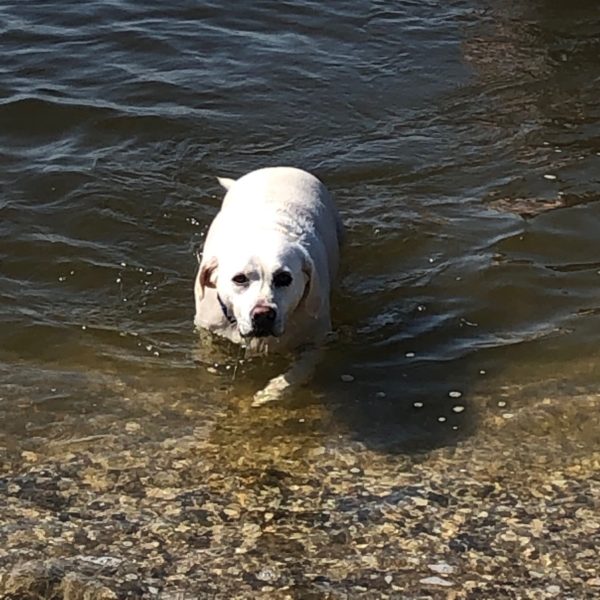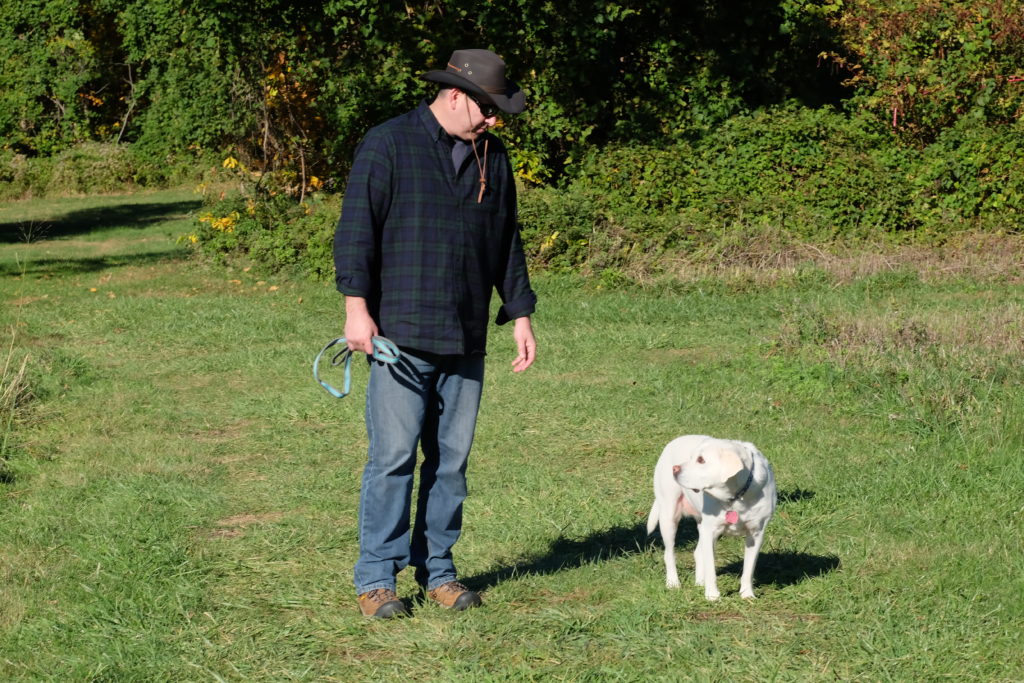While fur protects skin from the sun to an extent, dogs and cats can get sunburned, and they can develop skin cancer, too.
Dan Latore, former executive director of The Skin Cancer Foundation, learned this the hard way when his 10-year-old white lab, Tundra (in photo with Dan, above), was recently diagnosed.
Dan and his wife, Noël, and their two sons live on the Jersey shore, where Tundra has frolicked through the kind of idyllic outdoor life most dogs only dream of. “The first year of her life was right across the street from the bay and the beach,” Dan says. “We trained her to be off-leash, and she would swim, dig in the sand, run around with other dogs and play with our boys, who were about 8 and 10 when we got her. They all grew up together.”
Tundra loved walks in the woods, too, retrieving sticks along the way, where trees provided some shade. But she also attended sunny sporting events, like the boys’ football and baseball games. She would sometimes roll over to “sunbathe” and let the pink skin of her belly feel the sun’s warmth. If she got too hot, she’d try to find a shady spot.
Pets at Risk

Dan believes in consistent training from a young age; puppy Tundra’s classes made the local paper!
“Yes, dogs will seek the shade because they’re hot in their fur coats. So sometimes they’re smarter than we are,” laughs Dina Rovere, VMD, who (with her husband, Marko Sima, VMD), takes care of Tundra and other animals at Happy Tails Veterinary Hospital in Shrewsbury, New Jersey. Fur is great, she explains, because it reflects the sun, but it is not perfect, and white fur like Tundra’s is the least protective. Many dogs have fur-less areas on their bellies, so they can develop skin cancers there. And when the weather is cool or even snowy, they love to roll over and feel the warmth of the sun, while accumulating more skin damage from the year-round ultraviolet (UV) radiation.
Cats get skin cancer, too, and the tip of any pet’s nose, she says, is a prime spot for sun damage — especially if they have pink noses. (Black noses have more melanin pigment, which helps protect the skin a bit.) Ears, especially if they’re light-colored and stick up, are also very vulnerable, says New York City veterinarian Jill Abraham, VMD, who is board certified in veterinary dermatology. “We see squamous cell carcinomas (SCCs) on the ear tips of cats, on their noses and even on eyelids.”
As for dogs, Dr. Abraham says pit bulls, labs like Tundra and other breeds with light-colored fur, short coats and less hair on the belly are vulnerable to sunburn and skin cancer — “especially the ones that like to lie on their backs and sunbathe,” she says. Animals who have a condition that causes hair loss, such as certain skin diseases or allergies, or if they’ve been clipped short or shaved for surgery, are also at risk.
Warning Signs
Dan says Tundra had some lumps of fat (called lipomas) under her skin that had previously been diagnosed as benign. But one day while petting her, he saw something new that looked like a shiny bump on her skin when he parted her fur. Soon he noticed a few more: on her head, shoulder and back of the neck. One seemed to be growing, and they were unusual and felt harder than the squishy benign lumps under her skin.
He knew, from The Skin Cancer Foundation’s Big See early detection campaign, that “new, changing or unusual” are warning signs of skin cancer in people. Could it be the same for dogs?

Tundra loves swimming, but water reflects the sun’s harmful rays, and wet white fur doesn’t protect the skin well.
Yes, says Dr. Rovere. She explains that many people feel something on the skin while petting their dog or cat that they haven’t felt before. So they come in to have it checked out. If it doesn’t look serious, she might say, “Let’s wait and watch it.” If it’s more suspicious, she might collect a few cells with a fine needle aspiration to do a biopsy, or, if it’s growing, remove the entire lesion and send it to a pathologist to check for cancer.
Dr. Abraham agrees: “Keep an eye on your pets’ skin and watch for anything new, like a red spot or open sore that isn’t healing within a week or two, or that is changing or growing quickly, especially in an area of less hair.” Dogs and cats can get melanoma of the eye, too, so watch for a dark or “freckle-like” spot in the eye. See your veterinarian right away, as early detection of any type of skin cancer is the key to the least amount of treatment with the highest chance of a cure.
Tundra turned out to have several mast cell carcinomas, common in dogs, and Dr. Rovere performed Tundra’s surgeries. No further treatment was required, although after a life of unfettered freedom, Tundra was deeply offended by her cone and refused to wear it. She chewed out a few stitches on a rear paw, which Dr. Rovere had to resuture. “The stitches start to get really itchy after day three,” she explains. But once the scars healed, Tundra was fine.
“If the healing wound is on their pet’s foot, I tell people to get a tube sock and put some duct tape on it. That often works.” Putting a T-shirt or, for smaller dogs, a baby onesie on them over a wound can help keep them from bothering it.
Good Outcomes
 Dr. Rovere has found potentially life-threatening melanomas on dogs, and even recently discovered an amelanotic (colorless) melanoma inside a Yorkie’s cheek. She did additional surgery to assure clean margins, and the dog is now fine. “It makes me really happy that I saved that dog’s life,” she says. “We likely saved Tundra’s life, too. If we hadn’t taken those lesions off, they would have grown and gotten worse and probably would have killed her.”
Dr. Rovere has found potentially life-threatening melanomas on dogs, and even recently discovered an amelanotic (colorless) melanoma inside a Yorkie’s cheek. She did additional surgery to assure clean margins, and the dog is now fine. “It makes me really happy that I saved that dog’s life,” she says. “We likely saved Tundra’s life, too. If we hadn’t taken those lesions off, they would have grown and gotten worse and probably would have killed her.”
Dan says that Tundra has a limp from arthritis and is slowing down a bit, since she is in her mid to late 70s in dog years. “But it doesn’t stop her from jumping up on beds or couches — or running down the stairs when it’s dinnertime,” he says. “If there’s food involved, she’s there! She can’t do the long hikes she once loved, but she still likes to go outside (as in the recent photo, above, near Dan’s home in New Jersey).”
Dan’s boys are in college now, but Tundra is delighted to see them when they come home to visit. “We love that she has the energy to bring a stuffed animal into the room and basically say, ‘Come on — who wants to chase me?’ She still has a bit of puppy inside her.”
Treatment
Treatment options for dog and cat skin cancer are similar to those for people, says Dr. Abraham. Usually surgery is required, although sometimes laser surgery is an option. Radiation may be a possibility for some skin cancers. And cryotherapy, laser surgery or topical treatments are options for precancerous spots (yes, pets get those, too). And with recent advances in immunotherapy medications, there are veterinary oncologists saving the lives of beloved pets with advanced skin cancers, too. See our (human) Treatment Glossary for the basics on these.
Pet Prevention

Tundra resting after her surgeries for mast cell carcinoma. You can see the neat stitches and shaved areas on her scalp, back of the neck and paws. She’s healed and doing fine now!
Shade. The best protection for pets, veterinarians say, is to provide shade for them all year long, and get them out of the sun. Also, because animals don’t sweat the way people do, it’s harder for them to cool themselves. Don’t forget lots of water for outdoor pets. “And never leave a pet in a car unattended,” Dr. Abraham says.
Clothing. For pets who have to be out in the sun, consider clothing. “More companies are making rash guards and sun protection clothing for dogs,” Dr. Abraham says. “There might be some that cats could fit into, if you can get them to tolerate it! Even UV-protective T-shirts that are made for people could be an option for some dogs. And I know of at least one company that makes sun-protective eyewear for dogs.”
Window treatment. Remember that windows allow dangerous UV rays to penetrate, too, both at home and in your car, so you might consider getting sun protection film or shades for the windows.
Sunscreen. Dr. Rovere advises sunscreen for pets who are going to be outside a lot: “Say they’re going on a long hike on the beach and it’s high noon, absolutely. I tell people to put sunscreen on the nose and sun-exposed parts of the ears. Do what you can to protect them.”
Dr. Abraham says, “it’s best to distract the animal while the product dries completely so it’s less likely that they’re going to ingest any of it.” She recommends either a sunscreen that is made for dogs and cats, or a water-based sunscreen for babies. Sunscreens for people that contain zinc oxide can be toxic to pets if ingested.






